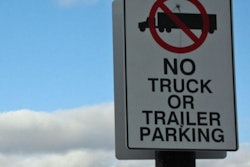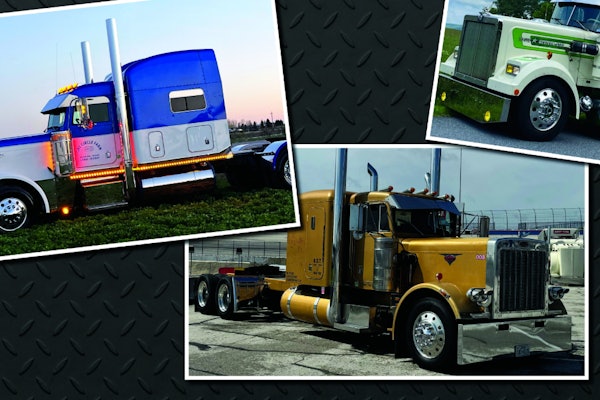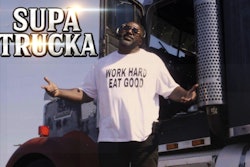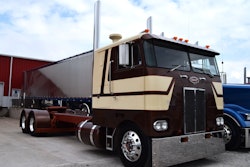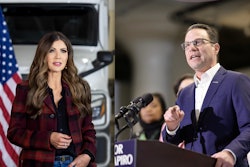Country Superstars use small fleets to haul their shows.
Thank heavens for the T-shirt truck.
When you have a fleet of trucks rolling through the night from one major music concert to the next, and something goes wrong, it can a be a lifesaver.
“The tickets have been sold; there’s no excuse for not getting everything there,” says Jim Freuck, a lead driver for a major country superstar who has been in just that position. “And you must get there on time.”
This summer, Freuck, in a gorgeous Pete 379 with a 600 Cummins and an 18-speed gearbox, was lead driver in command of 17 tractor-trailers hauling everything country star Kenny Chesney used in the monster concerts on his summer tour. In effect Freuck is a sort of fleet manager/driver on the road.
Chesney, born and raised in Luttrell, Tenn., has sold more concert tickets than any other country music act this year and was the ticket sales leader last year, too. In fact, only rock megastar band U2 has outsold him this year. Chesney is also the reigning CMA Entertainer of the Year and made last year’s CMA Album of the Year When the Sun Goes Down.
And he has a lot of fans waiting at each venue. His drivers are responsible for getting the complicated concert equipment there.

All but one of Freuck’s trucks is part of a sophisticated blueprint that lets them pack up the show’s equipment as soon as the show ends, drive through the night to the next venue and be ready to unload when most people are finishing breakfast.
But the T-shirt truck, which also carries other merchandise, doesn’t have to be there until later in the day. So when a transmission drops or some other mishap occurs, Freuck calls the T-shirt truck into service and begins to juggle his fleet.
“When we lost the transmission, we had to do some fast changes to the order of things,” says Freuck, who lives in the country north of Knoxville, Tenn. “One tractor dropped its trailer and went back and because the T-shirt trailer doesn’t have to be at the next venue until early afternoon, he dropped his trailer and went and picked up the first dropped trailer. Then all we had to do was go back for the T-shirt trailer. It does get exciting sometimes.”
Superstar artists still roll with a fleet of big rigs and buses. Freuck has been in charge of as many as 25 big rigs on a tour, in that case for the boy band Back Street Boys. In addition to the 17 tractor-trailers, Chesney’s tour uses 11 buses.
Freuck is a former truck mechanic, shop foreman and service manager at a trucking company, but he jumped at the chance to drive for a Kenny Rogers tour in 1980. “I had a friend who was driving at the time for the Allman Brothers’ “Eat a Peach” tour, and he asked me if I’d like to ride along. Later, the chance came up to drive for Kenny Chesney. It suited my lifestyle at the time, so I grabbed it.”
After a couple of years on the job, his employers, Upstaging – a Mundelein, Ill., company that is one of the leading players in the music tour business – discovered Freuck’s management skills and made him a lead driver, the man in charge of the fleet on the road.
“Funny thing, back then people were telling us that MTV would put live tours out of business and that I was making a mistake,” says Freuck.
When Freuck took over as lead driver for The Eagles’s fall and winter tour, it was his l00th tour that has included driving for such stars as Michael Jackson, Rod Stewart, Tina Turner, Simon and Garfunklel, Tom Petty and AC/DC. Sometimes the stars hire an experienced, specialist company like Upstaging; other times they lease the trucks and hire the drivers under their own company name.
Country star Toby Keith, born and raised in Oklahoma, leases his own fleet of eight Internationals. Driver Robert Law, 52, piloted one of them this summer, hauling equipment that made up Keith’s spectacular show.
Law, based in Wichita, Kan., has been driving since 1976. Law’s father drove a dump truck and when he died, Law took over. Soon he was working big rigs, end dumps hauling road construction materials, rock, sand and bulks such as grains. In the early ’90s he met Keith, who was then touring as an opening act. But Keith’s star was about to explode, and he was getting ready to tour as a headliner. “You’ll need more trucks when you do,” Law told him, “so call me when you’re ready to go.” Keith said he would and kept his word.
The prime concern of a music tour’s truckers, Law says, is “tight schedules with no room for mistakes. Sound check will be about 4 p.m. If we aren’t there at 8, it can’t happen at 4. With 300 miles maybe you have a little leeway, but 350 or 400 miles and it can get tight, so you want to get away on time. If it takes until 2 a.m. to load, that could be getting tight.
“With a produce truck or a truck with a regular load, being late might mean getting to the back of the line or being rejected, but we can’t be late. Period.”
Freuck’s blueprints for a show are as perfectly worked out as a battle plan and require just as much good timing and juggling when the unexpected arises. Each driver has a copy and knows when to be where.
When a Chesney show ends, usually somewhere around 11 p.m., 17 trucks are ready to load, waiting somewhere in the dark near the concert venue to come in according to their place in the lineup. By 8 a.m. they will be in place to unload, also in a strict order.
In addition to knowing every route to get to the next venue and every way in and out of it, lead drivers for big shows know they have no margin for error.
Not only have thousands of people bought tickets for the show, local crews have been hired to unload the trucks, and they will be waiting at 8 a.m. For big shows like Keith and Chesney, that could be as many as 100 people.
“Hours before the show you might have a few thousand people lined up waiting to get in,” says Freuck. “You’ve also got people inside the building waiting to start selling at the concession stands. You can’t be late.”
Being on time is essential for another reason. The star of the show puts his/her reputation on the line at each concert. If there’s not enough time to set up and check everything, the tour manager may have to cut some songs or some special effects. Perhaps sound or lighting setups won’t be competed and the show must change on the fly. The show might not be all that it could be. Audience expectations have to be met, says drivers, so they must give crews and entertainers the time they need to do it right.
But things don’t always go as planned. Traffic or highway repairs, a wreck or weather can bring the trucks to the new venue later in the morning. Then the unloading must be done as quickly as possible, and even then the tour manager may have no choice but to cut some parts of the show.
Tours are planned down to the smallest detail before they begin. Usually a group of two or three shows will be planned with a gap between. The grouped shows will be about 300 miles apart – 450 miles is a stretch – and the break allows people to rest and trucks to roll to where the tour resumes, maybe across country. Shows are also rehearsed before the tour starts, sometimes for weeks. It’s not only a chance for the artist to fine tune the show, it’s a chance for the people who set up and break down the equipment to work out how they will do it.
Lead drivers commonly turn up toward the end of rehearsal and work with the show’s production manager to find out how the equipment can be best loaded and unloaded, says Freuck. Even then it might take two or three stops on the concert tour to fine tune just how the convoy will work (although the trucks rarely roll as a convoy).
“When Kenny walks off the stage at the end of his show, the drivers are in their seats and we consider ourselves not working on this show but working on the next one,” says Freuck. “I can get 15 trucks loaded in maybe two and three-quarters hours, maybe three hours if there are only two loading docks. That means we’re loaded and on the road by 1 a.m or 1:30 a.m. (on the Back Street Boys tour, Freuck loaded 24 semis in under four hours).
Drivers on trucks waiting to load become helpers, and drivers on loaded trucks waiting to move out also help drivers backing and loading. The people who bring the equipment out to the trucks are also highly coordinated. Loaders pushing sound equipment to a trailer may have red T-shirts, the lighting equipment haulers heading to another trailer, yellow, or sometimes arm bands will be used. When four, five or more trucks are loading at once, it avoids confusion.
Most of the equipment is rented, and reps of the renting company go with big tours and supervise the installation and breaking down of their equipment. This is easier than it sounds as trailers usually carry a single kind of equipment – a sound truck, a lighting truck, a rigging truck and so on.
Loading or unloading, trucks roll in a set order because the show is “built” in a set order each time and taken down in reverse order when the show ends. “The crews that build the shows might finish the rigging then the stage gets moved into place in some cases, then the lighting guys can get to work, then the sound guys and so on,” Freuck says. “It takes them about six hours to build Kenny’s show and be ready for sound check.”
Last equipment on at end-of-show loading is first off next morning. And that is always the rigging truck, which is also the heaviest, often coming close to the maximum. The rigging is the scaffolding that will hold lights and motors over the stage, and sometimes over the audience, and raise and lower lights and other special effects.
“The rigging truck will weight out at close to the maximum,” says Law, “but most of the equipment in the other trailers is light. It makes it easier on the tractors, too.”
On Chesney’s summer tour as many as 85 motors were rigged. “Kenny does a lot of stuff,” says Freuck. “He’ll swing out over the audience from one end of the arena to the other, and that takes a lot of motor power.”
Local crews bring the equipment to the trailer on casters, and it is rolled onboard or rolled off at the other end. Each driver is responsible for making sure it is strapped down. Trailers are not packed to the doors. In fact, most tours could go with less trucks, says Freuck, but it is simpler to roll on and roll off equipment – and not have to stack it to the roof line as he did in his early days on tour. “We used to have drop deck frames so we could fill trailers up and that meant stacking,” he says. “Now we go for speed and efficiency; it saves time and money.”
Once the trailer doors are shut, the driver is responsible for the equipment. The equipment is held firmly with bars and ratchet straps, but it can shift. “There’s no room for cowboys driving this stuff. If a driver throws the truck around, the crews can always tell in the morning. I think maybe the best haulers are old bull haulers; they know how to keep it smooth,” says Law.
Food and drinks are waiting for the drivers as they load. Law says drivers load up with enough for the trip and put drinks in the cab fridge. “That way we don’t have to stop for food or drink on the road,” he says. “If we go to the truckstop, it’s just to gas and go.”
The trucks leave the show once they’re loaded and usually roll in twos or threes. And when trucks leave one concert for another, drivers live by Freuck’s advice: “The quickest way to get there is to keep the left door shut.”
The first trucks arrive at the new show venue somewhere about 8 a.m. within half an hour of each other.
“If we start at 8:30, we can usually be fully unloaded by 11:30,” says Freuck. “We have a basic formula, which we might have to vary a little depending on how big the arena is, what sort of access we have and how many docks there are. Some you like, some you hate to go to.”
Law says drivers go back to the same venues so often they get to know their quirks and find the best ways to get in and out of them in the best time.
Loading and unloading, drivers help each other. Some may help direct trucks back into the docks once they are finished; others will be swinging open the rear doors even as a truck backs toward its dock. Each driver is responsible for supervising the loading and unloading of his trailer.
Once the trucks are unloaded, they have to find a place to park. For Freuck this is a time where the drivers’ creativity is important.
“They have to park so they can come into the docks after the show is in order. But you can’t park in the car park – that’s for the show audience,” he says. “So they have to find somewhere. It may be against a fence or a wall, sharing a space with the police car, driveways, sharing space with fire marshals or even police cars.
In rare cases, it means sending the trucks miles away. Madison Square Garden in New York City, says Freuck, may find a space for one or two trucks, but they have no space and a lot of security concerns, so I have to send the trucks off to find their own places.”
Once they park, the drivers will eat lunch, then sleep. “For me that’s from 2 p.m. to about 10 p.m.,” says Freuck. “The cell phone is off, the truck is locked and I’m not to be disturbed.”
On Law’s Keith tour drivers would also eat and sleep, but they had the choice of a motel room instead of the sleeper. “We have sleepers, but they’re not usually used,” says Law. “I have a full sleeper with everything, but sometimes a motel room suits me better. It’s nice to have the choice.”
Drivers do face cross country hauls – Law made two cross-country trips in two weeks during the Keith tour – but the tour route is designed to give drivers plenty of time to handle long trips solo (while the star gets some needed rest and vocal chord rehabilitation). On the occasions when trucks must haul long distances in a hurry and a solo driver would not have enough log book time, teams are created by flying in drivers, who are later flown home when the show resumes it short hop routes.
That happens rarely because of the way the tour is arranged in advance and the fact that singers usually need two or three days to recuperate after a four-shows-in-four nights set. “Only once last year, I think,” says Law.
Tour drivers aren’t paid by the mile. It wouldn’t work, says Law. “There are a lot of urgent short hauls and then a break. You get paid for doing the job right.”
Freuck says his Upstaging crew is “usually made up of core guys, drivers with a lot of experience, but we’ll always have a couple of new guys coming along. The first thing I do is impress on them that we are 100 percent professional all the time. I take them into the show first night out and show them the people enjoying the show. That’s what we do; we help make them happy, and we don’t disappoint them or the people behind the lights.”
Freuck’s wife Kathleen says the drivers seldom receive the praise they deserve.
“If not for them, the show would not happen,” she says. “I was impressed by the fact that during his acceptance speech at the CMA Awards, Kenny Chesney even gave thanks to the truck drivers!”
Professionals, Not Buddies or Fans
Drivers on big tours are not encouraged to hang out with the stars of the tour. But they do get close enough to become workplace colleagues.
Lead driver Jim Freuck says Kenny Chesney threw a party for all the behind-the-scenes people on his tour on a free night, and Robert Law says Toby Keith rented a building in California for a closed-door party for the support staff on his current tour.
Law says the stars of the shows are easy to get along with, and Toby Keith will sit and eat with everyone else on the tour. “It’s really a tight-knit family on the road, and I see Toby a lot at catering or he’ll be out playing basketball,” Law says. “You get a lot of chances to talk when things are slow. Everyday stuff, you know; you don’t talk about the show or ask for autographs for friends. In the morning at breakfast or in the production office it’s easy to chat, but you don’t bother an artist before a show when they are trying to focus.”
Freuck’s wife Kathleen says, “A lot of people think that it must be a glamorous job and that Jim is out there having a great time, seeing the shows, hobnobbing with the stars, etc., but in reality he rarely ever gets to see the show, unless they are in a city for multiple nights.”
It’s clear the drivers like and respect the people they’re hauling for, but, says Freuck, when you get a chance to stop and talk, you take it, but don’t abuse your access.
The occasional star-struck driver will want to hang out with the band back stage, but it’s frowned upon.
“Someone who goes to every show and hangs out back stage is not concentrating on his job,” Freuck says. “They tend to get weeded out or not asked back. We’re professionals, not fans.”
Big Ticket Items
How do the big touring acts pay for the traveling show that rolls with them in buses and big trucks?
Concerts are big business, very big. And Kenny Chesney is the best seller of all.
According to Pollstar, in the first half of this year the top 100 touring acts sold 14.5 millions tickets at an average price of $50.27, bringing in $731 million.
Chesney sold 610,000 tickets at an average price of $57.39. While the Irish rock band U2 grossed more money than any other act, Chesney was by far the biggest ticket seller. Chesney’s 610,000 tickets so far this year compared to the Irish band’s total of nearly 500,000.
But, says Pollstar, the total tickets sold by the Top 100 tours was down by nearly 2 million over last year, and the Top 100 Tours’ gross was 17.2 percent or $152.2 million under last year’s $883.1 million.
Pollstar, the concert industry’s leading trade publication, provides music business professionals with worldwide concert tour schedules, ticket sales results, music industry contact directories, trade news and unique specialized data services.
Keeping It Light
The blockbuster acts that can fill football stadiums with spectacular shows still rely on the big rigs to get their shows from one night’s venue to the next, but mid-size and smaller acts are using big rigs less and less.
“You don’t always need semis if you have a compact show like we do,” says Greg Wright, road manager for Sammy Kershaw, the voice behind such hits as “Cadillac Style,” “Don’t Go Near the Water,” “National Working Woman’s Holiday” and “Queen of My Double Wide Trailer.”
“And with fuel prices being the way they are, there is a lot of incentive to downsize. Today even running two semis and two buses is something we want to avoid. We’ll run two tractor-trailers and two buses if the venues are big enough and the schedule calls for it, but we try to avoid it.”
The key to music acts traveling light, says Wright, is the availability of high-quality equipment that is easy to rent at local venues, coupled with the proliferation of lightweight, smaller equipment such as speakers and lights that can easy be hauled without a semi.
“It’s more feasible these days for us to put on a full show with less equipment, at least in terms of size and weight,” says Wright.
For example, at this year’s Great American Trucking Show in Dallas, headliners Kershaw and Terri Clark both arrived without trucks and still put on stunning shows.
Some smaller use one or two trucks, but even then the driver is largely confined to being in charge of transportation matters. “Today the drivers on most shows, big or small, are just drivers,” Wright says. “They don’t have the time to string guitars or set up stages; they have to sleep so they have enough hours to drive overnight to the next show.”
The only guy on a Sammy Kershaw tour who might do that is Kershaw himself, who has been known to get behind the wheel of a tractor-trailer and do the driving work himself.



